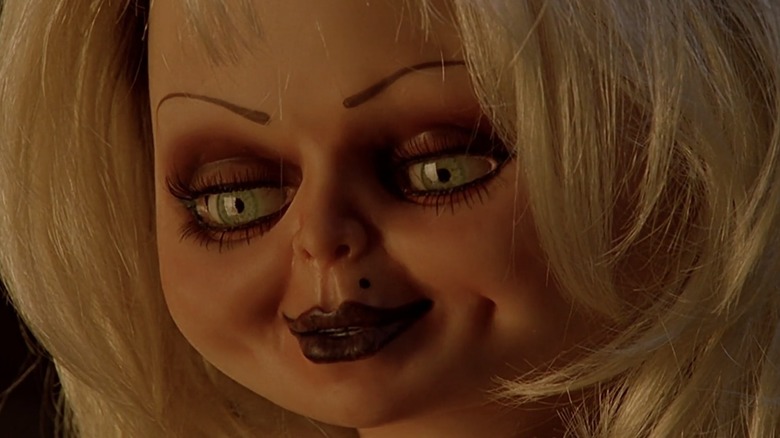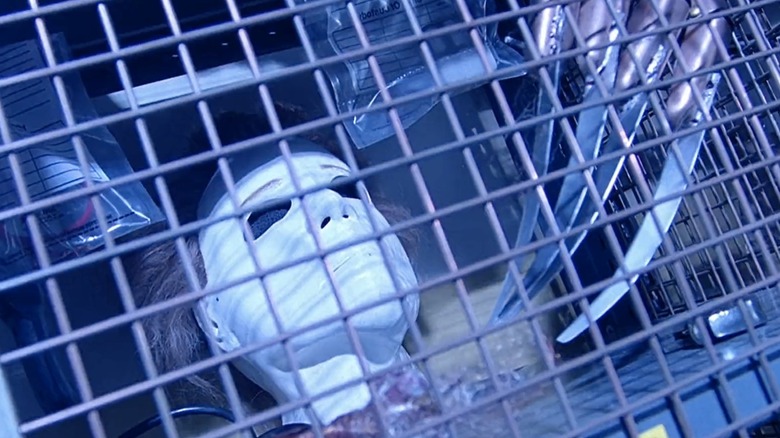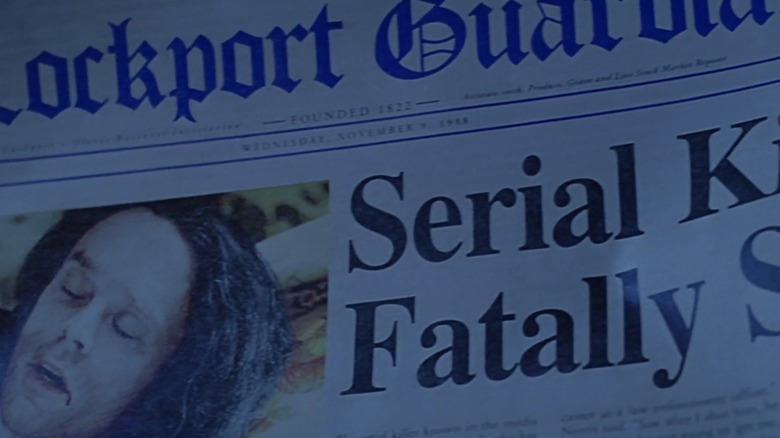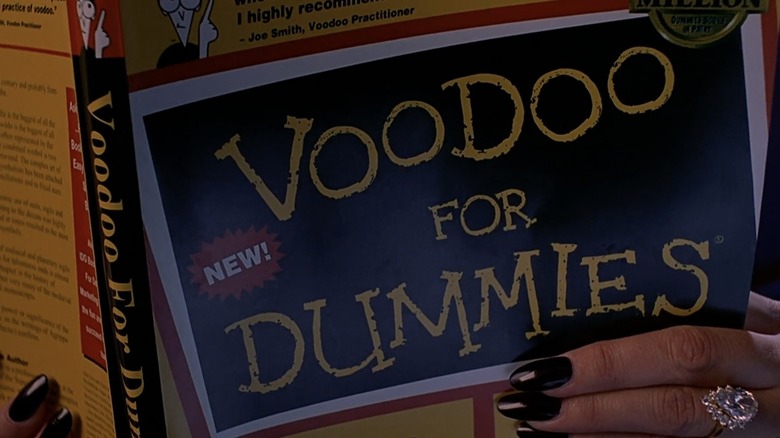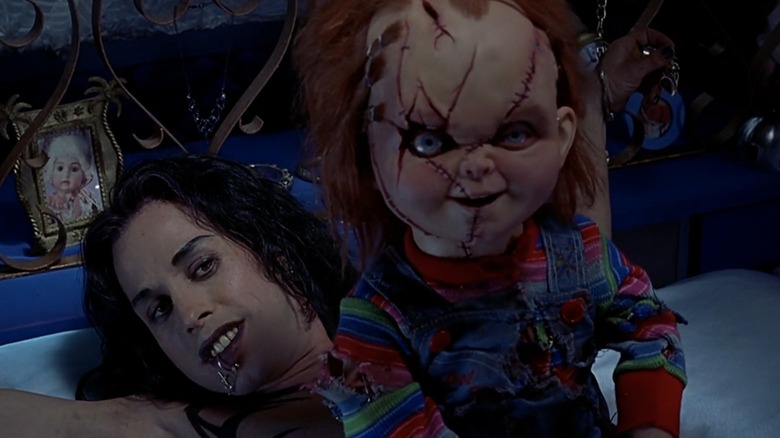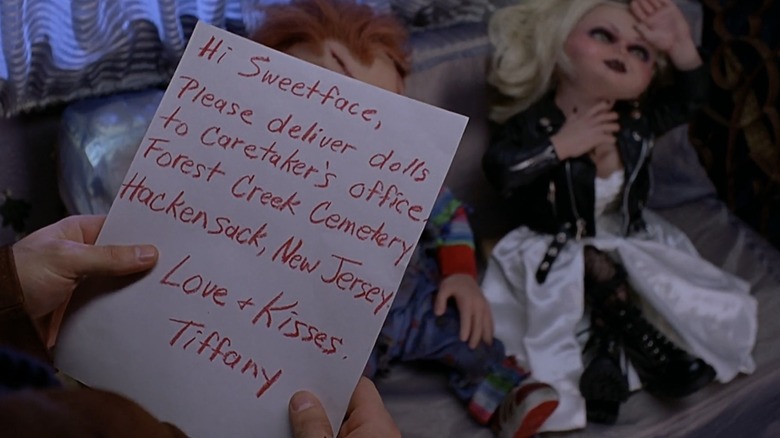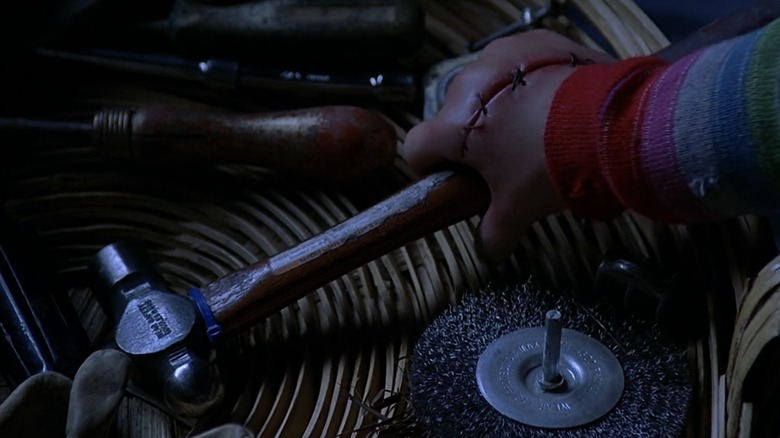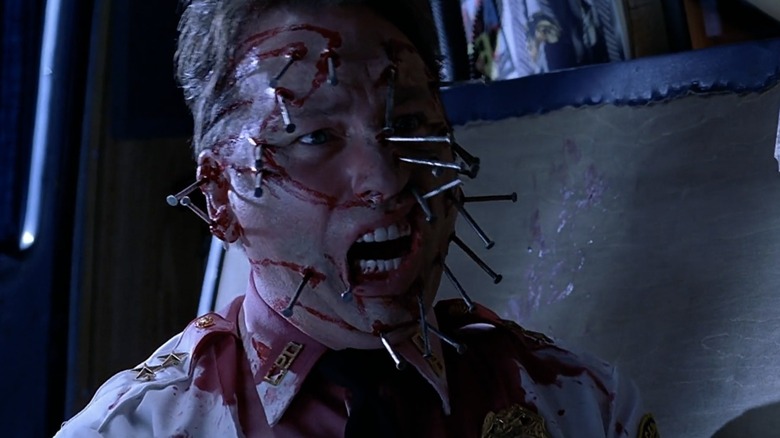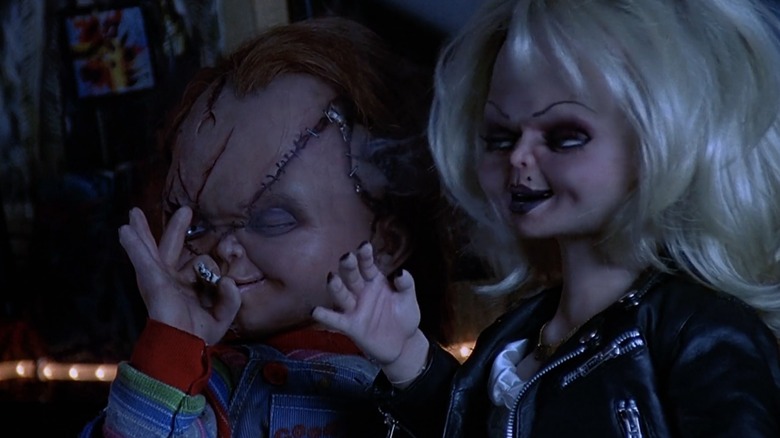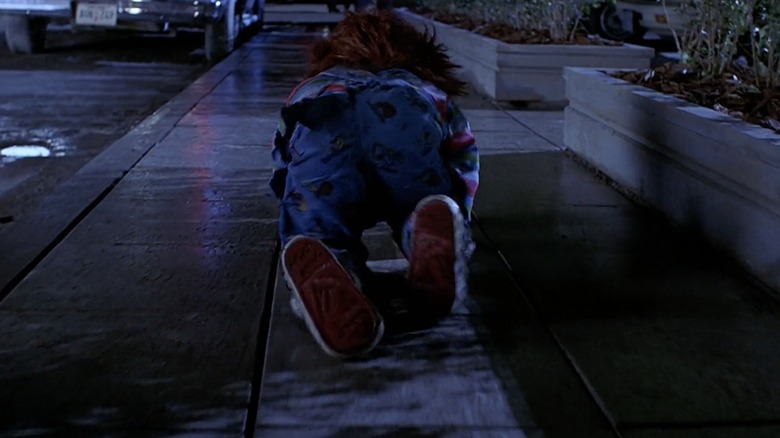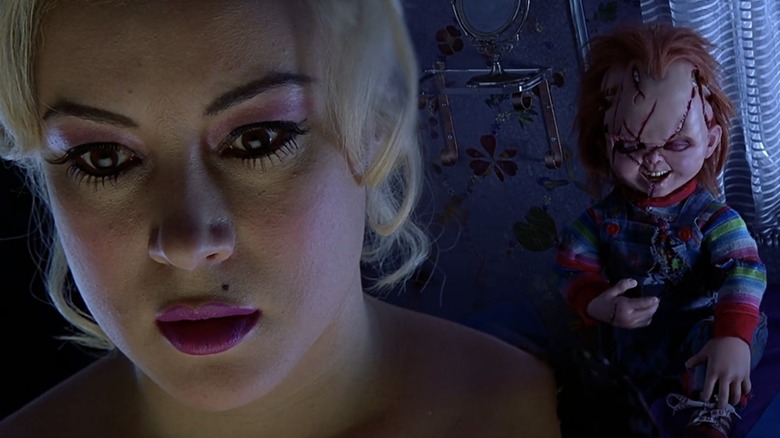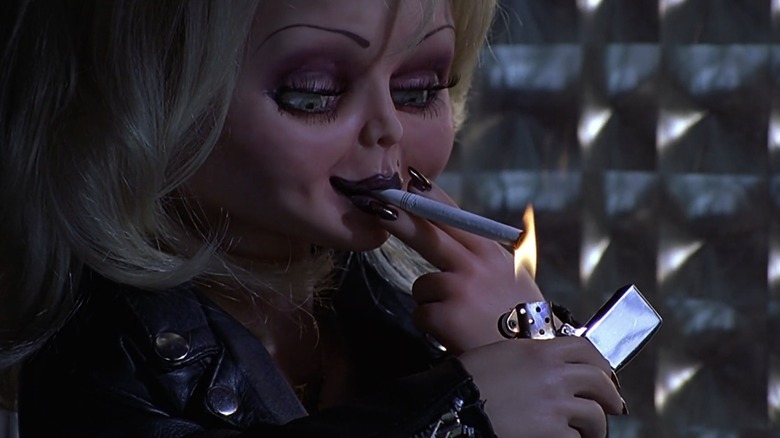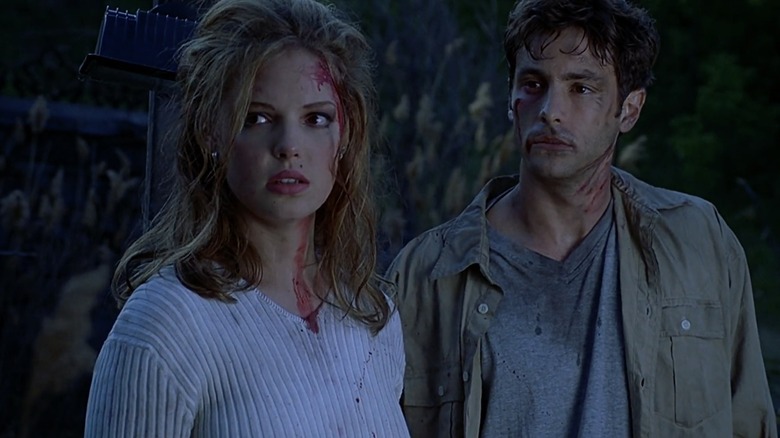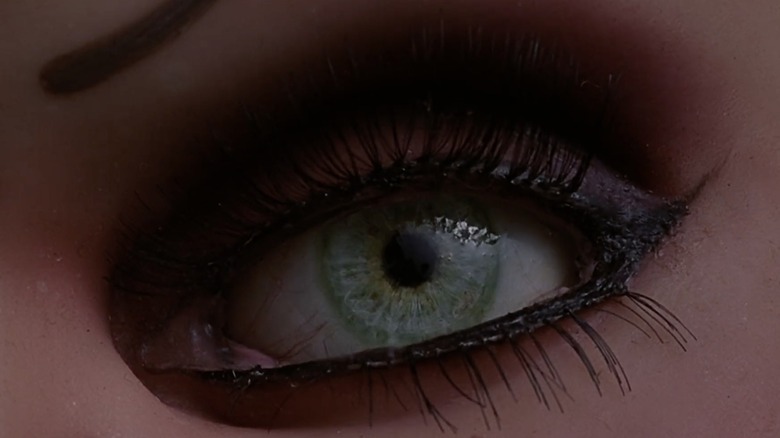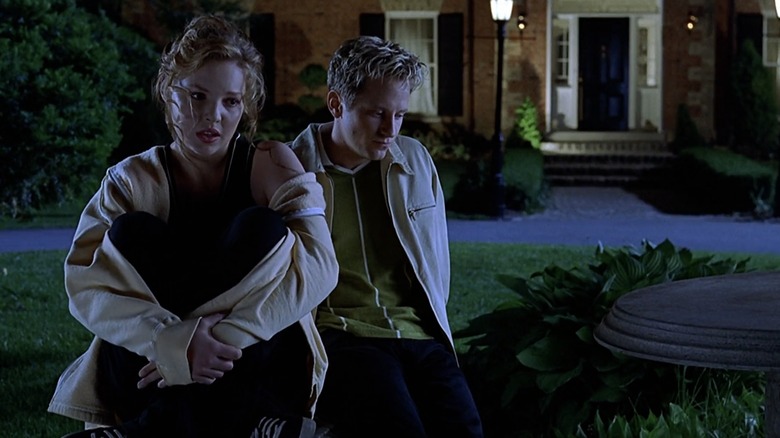Things About Bride Of Chucky You Only Notice On A Rewatch
After the critical and financial failure of 1991's "Child's Play 3," the once-promising horror franchise was in dire need of a new direction. In the self-referential genre climate of "Scream" and "I Know What You Did Last Summer," a pivot into goofier and more self-aware territory was in vogue.
Somewhat infamously, "Bride of Chucky" is the film where "Chucky Gets Lucky." Torn to ribbons by a giant fan in "Child's Play 3", Chucky's mangled remains find their way into the possession of Tiffany Valentine (Jennifer Tilly), Chucky's one-time girlfriend back when he was human. After bringing Chucky back from the dead, Tiffany learns the hard way that she overestimated the strength of their relationship. By "the hard way," we of course mean "Chucky traps her soul in a doll." And so, couriered unwittingly by two teenage lovebirds (Katherine Heigl and Nick Stabile), the homicidal pint-sized couple set off on a road trip/murder spree.
Brimming with on-the-nose cultural references to drag Chucky, kicking and screaming, into the '90s, "Bride of Chucky" benefits from a distinct Hong Kong horror flair thanks to the direction of Ronny Yu. A delicious slice of genre cheese, what "Bride of Chucky" lacks in critical praise, it more than makes up for in blood and enthusiasm.
Naturally, with such a bold effort to enter the realm of self-parody, "Bride of Chucky" is full of details and connections that you may only notice on a second viewing. So, let's get into it: Here are some of the easter eggs and deeper implications that only become crystal clear the second go round...
The evidence locker is a treasure trove of horror easter eggs
Right out of the gate, "Bride of Chucky" kicks the door down with a smorgasbord of delectable in-jokes for genre fans. Before the opening credits even roll, we join Jo Bailey (Vince Corazza) as he makes his way into quite possibly the most intriguing evidence locker in cinema history. Bailey, a cop in need of some ill-gotten cash, is at the locker to retrieve Chucky's dismembered remains for the film's anti-heroine Tiffany Valentine (Jennifer Tilly). Conveniently illuminated by the lightning storm outside, several pieces of "evidence" look a little, shall we say, familiar?
While iconic horror artifacts like Jason's hockey mask and Michael Myers' pale rubber visage are unmissable, catching all the evidence locker's gruesome goodies requires a keen eye and at least a second watch. Eagle-eyed viewers can peep Leatherface's chainsaw and Freddy's clawed glove, as well as harder-to-spot nods like the demonic mounted deer head from Sam Raimi's "Evil Dead II".
Considering that director Ronny Yu would go on to direct the monster mash flick "Freddy vs. Jason" five years later, the evidence locker's implication that all these horror legends live in a shared universe is, at the very least, a snarky bit of fun. Which is, at the end of the day, what the "Child's Play" franchise is all about.
The date on Tiffany's newspaper clippings
After bringing Chucky's dismembered remains back to her mobile home, Tiffany giggles with glee as she stitches various doll parts together into a more or less complete Good Guy doll. As she sews away and shoves brand new glass eyes into Chucky's sockets, we enjoy a tiny tour of Tiffany's home. As the camera pans its way through her humble abode, we are treated to a couple of headlines from the newspaper clippings Tiff's amassed over the decade since Charles Lee Ray's death.
One newspaper in particular, the Lockport Guardian, features a front-page story from the day Charles Lee Ray was gunned down. It's difficult to see, but in very small print, you can spy the date of the paper's release: November 9th, 1988. Huh, why does that sound so familiar? Oh that's right: the original "Child's Play" was released theatrically on that very day. Interestingly, the paper's date seems to imply that if you were watching the original "Child's Play" on opening day, the events of Charles Lee Ray's death were playing out more-or-less in real time. It's a nice little touch, and proof that it always pays to read the fine print.
"Voodoo for dummies" is a pun
Chucky and Tiffany are perfect for each other: they're homicidal, get aroused by violence ... oh right, and they're both voodoo practitioners. At the beginning of the film, after retrieving the bits and scraps of the Good Guy doll from the storage locker, we join Tiffany in her extremely 1990s mobile home, which, in addition to all the decorative butterflies and glitter, features a disconcerting amount of dolls. But Tiff's no antique collector. As we quickly learn, she's been amassing her collection in order to build up a back catalogue of spare parts to re-assemble her plastic lover. And from the looks of her sulfur pentagram and the "Little Book of Love Spells" under her radio, she's dabbled in the dark arts before.
Not only that, but right from her on-screen introduction where she slits a cop's throat, it's clear that Tiffany is sharp, sly, and savvy. So what, exactly, is a smart spooky lady doing with "Voodoo for Dummies"? The book's true punchline doesn't reveal itself until Chucky transfers Tiff's soul into a doll. Suddenly, her tiny fake fingers gripping the edges of the book, the word "dummy" takes on a darkly funny, plastic, meaning.
Damien Baylock's name is a reference to a satanic classic
Sadly, Tiffany's arachnophobic goth admirer Damien Baylock (Alexis Arquette) is not long for this world. Which is a shame considering their name is, as far as horror nods are concerned, absolute aces. But hey: if you're going to get murdered in a "Child's Play" movie, there are worse ways to go than being smothered by a recently re-animated Good Guy doll. Just saying.
Originally named Howard Fitzwater, Baylock's new and decidedly cooler name is a nod to one of horror's great satanic masterpieces, which is appropriate considering the occult-leanings of the "Child's Play" franchise. The hapless goth's name is a reference to two nefarious characters in Richard Donner's 1976 supernatural horror film "The Omen": Damien (Harvey Stephens), the son of Satan, and Mrs. Baylock (Billie Whitelaw), a mysterious new nanny who arrives after Damien's previous minder hangs herself at a birthday party. While the name "Damien" is eternally connected to the pint-sized Antichrist, the nod to Mrs. Baylock is easier to miss. Which is odd, considering the pivotal role Mrs. Baylock plays in the film, launching our protagonist's wife Katherine out a hospital window and attempting to do away with our intrepid hero before being stabbed to death. It's a fun nod and we're sure Satan is very proud.
The deeper meaning of Tiffany's nickname for Jesse
Fans of the "Child's Play" franchise with especially good memories may notice that Tiffany's recurring pet name finds its origins with Jesse. In "Bride of Chucky", Tiffany refers to her trailer park neighbor as "Sweetface" and later in the franchise, she seems to mutate the term from a manipulative jeer to a more endearing moniker for her genderfluid spawn (voiced by Billy Boyd) in "Seed of Chucky" (2004).
Jesse isn't exactly the most, uh shall we say memorable presence in "Bride of Chucky." But he's competing with two homicidal dolls, so we'll give him a pass.
All told, Tiffany holding on to Jesse's nickname really hammers home her soft spot for the kid (she was planning on boinking him after stealing Jade's body, after all). So, you know what they say: If you can't transfer your soul into the body of your sweet-faced neighbor's girlfriend, you might as well transfer your pet name for him to your androgynous offspring.
Why the hammer is "predictable"
While Chief Kincaid is on a mission to plant drugs in Jesse's van, our murderous, doll-sized lovebirds mull over how, exactly, they're going to murder him. Chucky is more than happy to stay in his 1980s slasher lane, gleefully eyeballing a nearby knife (why there is a shiny knife in Jesse's van is a mystery). But Tiffany wants something a little more ... creative. Begrudgingly, Chucky waddles over to a nearby toolkit, where he spies the perfect blunt instrument: a hammer. Tiffany, unsatisfied, comments that the hammer would be "predictable".
While this comment might sound a little strange on the first go round (are hammers that predictable?), on a second pass, you may catch on to the true meaning of Tiff's remark. As astute fans of the "Child's Play" franchise will remember, Chucky has, in fact, used a hammer as a murder weapon before. In his first cinematic outing back in 1988, Chucky's bludgeoned the babysitter Maggie with a Good Guy brand hammer, knocking her out the window to her death. Gosh, we knew that Tiffany was keeping an eye on Chucky's exploits from all the newspaper clippings, but that's some real attention to detail on her part.
Chucky's a Clive Barker fan
One of the more creative kills in "Bride of Chucky" involves an airbag, an unsuspecting police chief, and a lot of nails. Teen lovebird Jade (Katherine Heigl) is the niece of the very possessive, and very stupid Chief Warren Kincaid (the late John Ritter). Chief Kincaid isn't a huge fan of Jade's boyfriend Jesse (Nick Stabile). So, in an attempt to foil their relationship, Chief Kincaid breaks into Jesse's van to plant a bag of marijuana. Fortunately for Jesse, Chief Kincaid's corrupt antics run afoul of Chucky and Tiffany, who are using the teen lovers to get their tiny plastic hands on the magical amulet that will allow them to transfer their souls into human bodies.
This leaves Chief Kincaid crawling on his hands and knees, straight into Tiffany and Chuck's barrage of nails, which plant themselves evenly throughout the police chief's anguished face. As the doll-sized couple gaze upon their handiwork, Chucky asks (more to us, the audience, than to Tiffany): "Why does that look so familiar?". Well, Chucky, that spiky head might be reminding you of a more famous nail-noggin: Pinhead from Clive Barker's 1987 gore-masterpiece "Hellraiser."
As his name suggests, the lead Cenobite (a role originated by Doug Bradley), has a head full of, well, pins. The original "Child's Play" was released in 1988, so technically Charles Lee Ray could have caught a "Hellraiser" screening while he was still human. You heard it here first folks, Chucky's a horror nerd ... just like the rest of us.
Chucky lighting up is a bad strategic move
Let's remind ourselves of Chucky and Tiffany's plan. The pair need to get to a graveyard in New Jersey to retrieve the amulet wrapped around Chucky's decaying human corpse. They need the amulet (which, by the way, is nowhere to be found in the original "Child's Play"), in order to transfer their souls out of the dolls they currently inhabit. Teenage lovebirds Jade and Jesse are transporting the dolls to the cemetery, on the pretense that they're two valuable, if spooky, collector's items. Suffice it to say, it is in Chucky and Tiffany's best interest to keep themselves — and their unsuspecting human chauffeurs — out of trouble.
Instead, on a rewatch you might notice that Chucky and Tiffany seem to actively throw Jade and Jesse under the bus, turning them into wanted criminals despite their very real need to keep a low profile. The most baffling instance of this takes place at the rest stop where Jade and Jesse are pulled over by a pesky cop. While Jesse and Jade freak out outside, and the cop prepares to search the vehicle, both dolls light up joints and giggle, clearly unaware or unbothered by the potential incarceration of their meal ticket. We don't expect rocket science from these delinquents, but surely this celebratory puff could wait?
You can tell when Chucky is a guy in a suit
Sometimes, when you return to a film for a second viewing, you can turn off your immersion and think about how the filmmakers actually made the movie. For the most part, Chucky and Tiffany appear on-screen as pretty dang impressive animatronic puppets. However, if you're paying close attention, you can spot a couple of instances where Chucky is powered by a person rather than a heaping complex of servo motors.
One moment stands out in particular. During the scene at the rest stop where Jade and Jesse are questioned by a nosy police officer, Chucky leaves the safety of the van to ignite a shirt stuffed in the cop's gas tank. As he crawls between the cars, you can tell that there's something a little "off" about his speedy crawling. Part of what makes Chucky so creepy is the uncannily doll-like restrictions of his movements and facial expressions. So when he moves fluidly, and you're paying close attention, it's a little jarring. For the curious: The man-in-the-suit in question is most likely Ed Gale, credited as Chucky's stunt double in "Bride of Chucky" as well as the first two "Child's Play" outings.
"If it was a movie it would take three or four sequels just to do it justice"
Every good villain loves to monologue, and Chucky is no exception. After finally revealing his (and Tiffany's) true nature to the hapless couple Jesse and Jade, our pint-sized maniac is tasked with explaining how, why, and what he is. After Jesse (who, to his credit, is not nearly as freaked out as he should be all things considered) asks the pair how they wound up trapped in their plastic prisons, Chucky responds that "it's a long story ... in fact if it was a movie it would take three or four sequels just to do it justice".
You're right, Chucky, it would take three or four sequels, wouldn't it? "Bride of Chucky", the fourth entry in the franchise, was preceded by "Child's Play" (1988), "Child's Play 2" (1990), and "Child's Play 3" (1991). It's a fun, eye-rolling joke that is especially groan-worthy if "Bride of Chucky" is your entry point to the "Child's Play" films. After digging deeper into the franchise and re-visiting "Bride of Chucky" with the context of the sequels, this line simply hits different. Now if only Chucky could have predicted the three more sequels to come and the 2019 reboot, that would have been impressive.
Tiffany is the protagonist
Sure, it's Chucky's franchise, but "Bride of Chucky" is Tiffany's movie. The film is named after her for a reason.
During a rewatch, knowing how "Bride of Chucky" unfolds makes it plain that Tiffany is the emotional center of the film. Jade and Jesse, the teenage lovebirds, are about as interesting as wet cardboard; Chucky, for all his devil-may-care charms, is still the same old Good Guy doll we met in the first film, albeit more flagrantly silly.
Tiffany, on the other hand, is the only character with an honest-to-god emotional arc. At the beginning of the film, the obsession with resurrecting her former lover has completely consumed her life. After getting caught up in Chucky's homicidal shenanigans, it's obvious that Tiffany is still a hopeless romantic, and that the heartless Chucky is going to hurt her once again.
However, by the film's bloody, charred conclusion, Tiffany finally resolves to break it up with Chucky once and for all, reciting the infamous "we belong dead" line from "The Bride of Frankenstein", and putting her toxic boyfriend in the grave for good. Well, at least until the sequel.
Jesse and Jade are absolutely getting divorced
Of all the on-screen couples in "Bride of Chucky," you'd be safe to assume the murderous possessed dolls have the most toxic relationship. While, sure, Chucky and Tiffany aren't exactly relationship goals by any means (there's literal backstabbing for cryin' out loud), Jade and Jesse aren't exactly a model example of healthy romance either.
Despite being so madly in love with each other that they're willing to run away together, these teens are very quick on the draw to accuse each other of the murders Chucky and Tiffany are actually committing. On a rewatch, it's painfully obvious that these two lovebirds have some serious trust issues and that married life probably won't pan out for them.
If you're that quick to go all-in on accusing your partner of homicide, maybe you're not ready to elope. Heck, when Jesse and Jade do get hitched, despite both believing the other one is a cold-blooded killer, their binding kiss is so forced and uncomfortable, we're not sure why the minister didn't immediately call the cops. Even though Jesse and Jade prove their innocence to one another once Chucky and Tiffany reveal themselves, can you really come back from your new spouse fingering you for murder without skipping a beat? Probably not. Sure, their records as wanted criminals are cleared, but there's no way their marriage is going to last.
What happened to all the voodoo rules?
Picture this: you're marathoning the "Child's Play" franchise, and you finally get to "Bride of Chucky." The words of John "Dr. Death" Bishop (Ray Oliver) from the original film are still ringing in your ears: The longer Chucky's soul is trapped inside a doll, the more human his plastic vessel will become. Dr. Death never gave Chucky a timeline of how long this "human-ification" process takes. But we have to assume that at least a couple of days has passed between Charles Lee Ray being gunned down in the kids store and doll-Chucky noticing that he can bleed.
Meanwhile, upon second watch, Tiffany's doll-body proves capable of organic functions in a head-spinningly fast period of time. Not only is she capable of smoking cigarettes and crying, she's able to have intercourse and conceive a child. Her doll-eyes also change from green to blue for some reason (even though Tiffany's human eyes were brown).
If we assume Jesse and Jade hit the road the same night Tiffany's soul is transferred into a doll (which seems likely), it only takes her a couple of days to develop a fully-functional (and uncomfortably accelerated) reproductive system. While "Bride of Chucky" is certainly goofy enough to be immune to this kind of nitpicking, it's still a bit jarring when you watch the franchise back-to-back. Is wanting consistent rules and goofiness such a crime?
"Bride of Chucky" brought a queer sensibility to the franchise
With "Bride of Chucky," the "Child's Play" films doubled down on the dark comedy that lurked in the background of the franchise's first three outings. It also, more subtly, carved out a space for the franchise within the vibrant sub-genre of queer horror cinema. From placing a queer icon like Jennifer Tilly front and center (cast, no less, for her sapphic turn in the Wachowskis' "Bound") to the positive representation of David, an openly gay character, "Bride of Chucky" more broadly featured a more open sensibility than your common horror franchise.
"I was sort of consciously injecting some gay identity into it, and people really embraced that," Mancini, himself an openly gay man, told Buzzfeed News. "I think it's important — in addition to being fun — because you just don't see it much in the horror genre. ... One of the distinguishing factors of our franchise is that it has a certain gay identity." Being aware of the film's queer status, there are parts of "Bride of Chucky" that simply hit different, from a character played by trans activist Alexis Arquette to Jade's remark that, given her abusive guardian, she really wishes she could "choose her own family."
